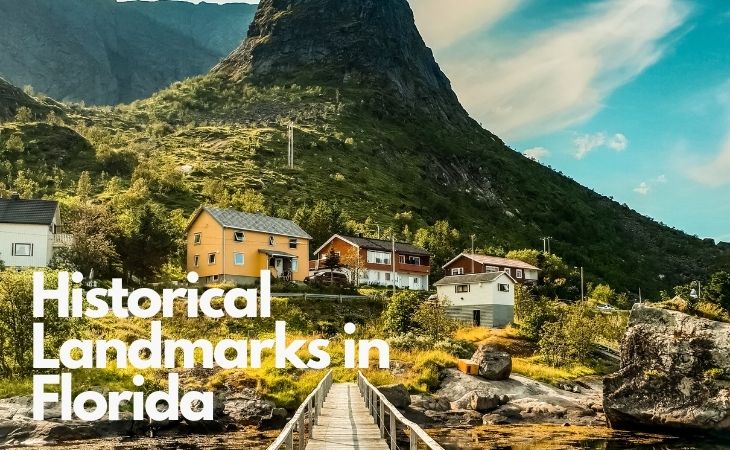Florida isn’t all amusement parks and beaches, contrary to popular belief. There is a plethora of historical significance and national landmarks. The National Historic Landmarks in Florida cover a wide range of time periods, from pre-Columbian antiquity to the Second Seminole War and Civil War, as well as the Space Age. In Florida, there are 47 National Historic Landmarks (NHLs) spread over twenty-two of the state’s sixty-seven counties. Sixteen of the state’s NHLs are noteworthy examples of a particular architectural type, eleven are military sites, ten are archaeological sites, three were the residences of well-known American authors, and one is linked to the creation of the United States Space Program. Here are 14 incredible Florida’s historical landmarks to check off your bucket list.
Dry Tortugas National Park
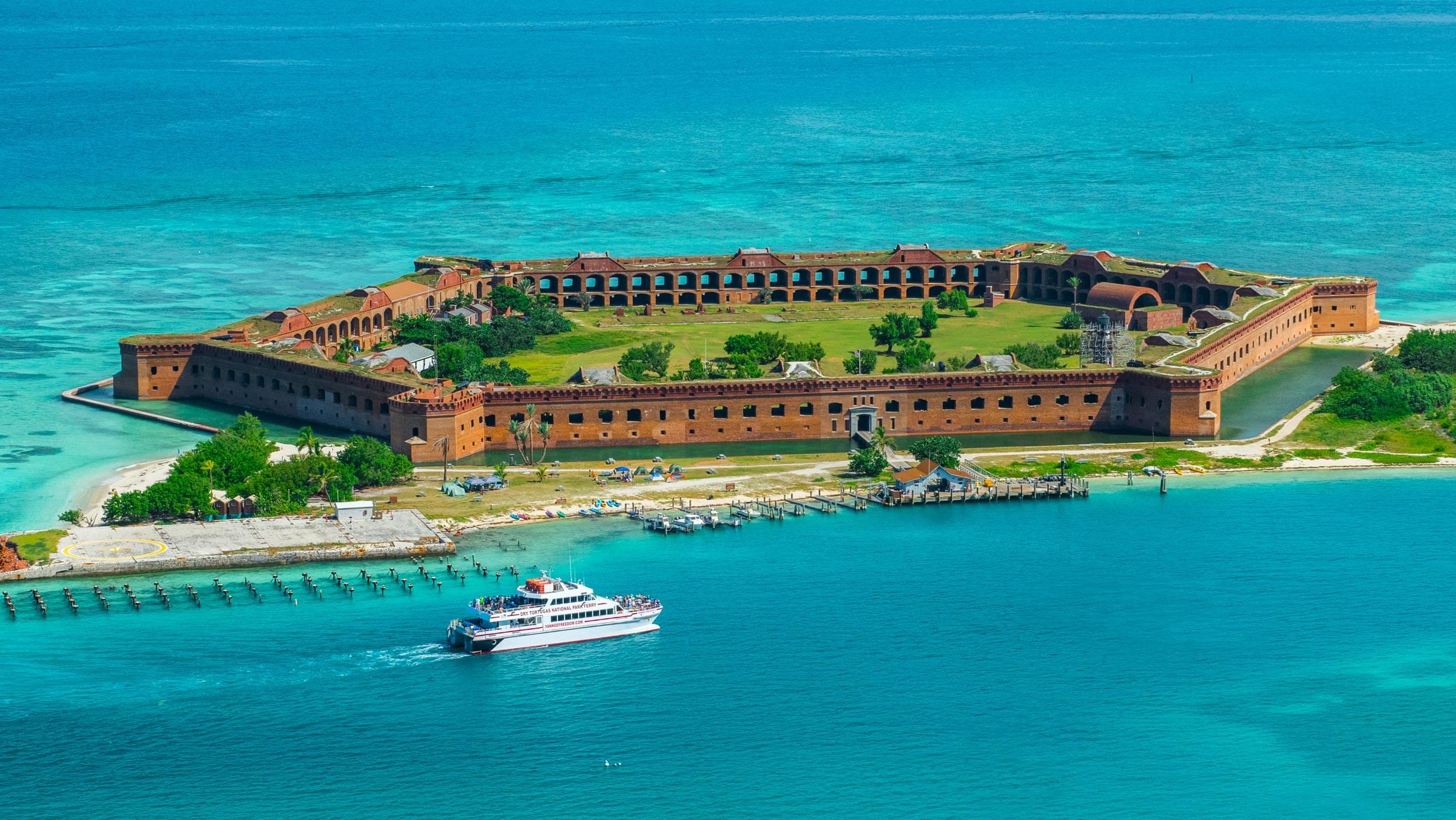
The impressive Fort Jefferson, built by the US government in the 1800s, is located in Dry Tortugas National Park. The beautiful reef islands that make up the Dry Tortugas, which number seven in total, are worth the trip even if this is the park’s main attraction. You can tour the fort and then relax on the soft sand beaches or go snorkelling in the beautiful, shallow seas.
These islands are 70 miles west of Key West and are inaccessible by automobile. Visitors can spend the day here on a catamaran boat cruise from Key West, which includes a tour of the fort, time for beaching and snorkelling, plus breakfast and lunch.
You can even camp here and have your own desert island adventure once the visitors have left for the day. Private boats or a public ferry carrying a maximum of 10 campers are the only ways to get there.
Coral Castle
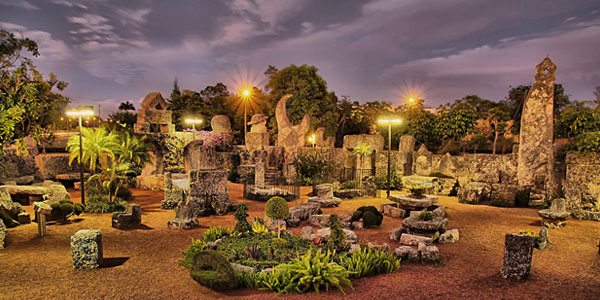
Edward Leedskalnin (1887–1951), a Latvian-American eccentric, built Coral Castle out of oolite limestone. It is situated between the cities of Homestead and Leisure City in unincorporated Miami-Dade County, Florida. The edifice is made up of a number of megalithic stones, most of which are limestone created from coral and weigh several tonnes each. It is now a tourist attraction run by a private company. The stories surrounding the construction of Coral Castle state that Leedskalnin built it all by himself, using reverse magnetism or supernatural ability to move and chisel huge stones weighing hundreds of tonnes.
It isn’t a castle, and it isn’t entirely constructed of coral, at least not in the traditional sense. Everyone is still baffled as to how he carved over 1,000 tonnes of limestone (made up of coral skeletal bits). Coral Castle’s allure stems from its mystery.
Bok Tower Gardens
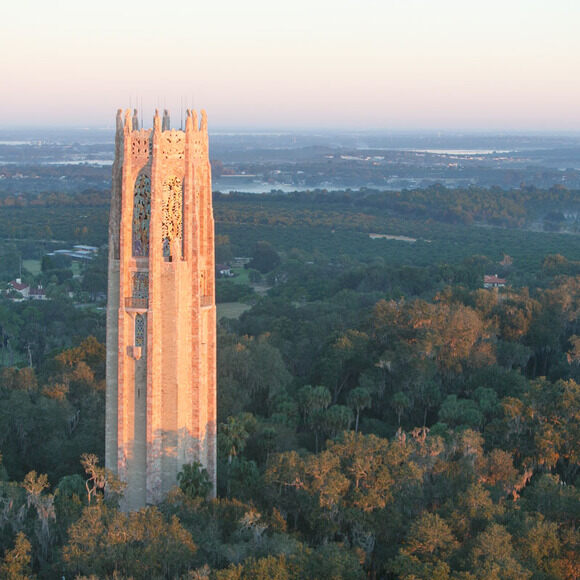
Bok Tower Gardens is a 250-acre (100-hectare) meditation garden and bird sanctuary on Iron Mountain, north of Lake Wales, Florida. The gardens’ features include the Singing Tower and its 60-bell carillon, the Bok Exedra, the Pinewood Estate, the Pine Ridge Trail, and the Visitor Center, which were previously known as the Bok Mountain Lake Sanctuary and Singing Tower.
The gardens of Bok Tower are a National Historic Landmark. The Singing Tower, which is 205 feet (62 metres) tall and is listed on the National Register of Historic Places, was built atop one of peninsular Florida’s highest elevations, believed to be 295 feet (90 metres) above sea level.
The gardens and their tower have national significance because of their ties to Edward W. Bok and his design team. El Retiro is a separate National Register listing for the neighbouring Pinewood Estate. The Bok Tower Gardens are open every day and demand an admission fee.
Stiltsville

Stiltsville is a neighbourhood in Miami-Dade County, Florida, one mile south of Cape Florida, on the sand banks of the Safety Valve on the border of Biscayne Bay. The structures are ten feet above the shallow water, which is one to three feet deep at low tide, and are supported by wood or reinforced concrete pilings.
Stiltsville began in the 1930s as a collection of offshore clubs in Miami-Dade County, roughly a mile south of Cape Florida. These clubs were popular hangouts for wealthy and powerful visitors who wanted to engage in vices like gambling. In 1965, a cyclone destroyed the structures beyond repair. The National Park Service looks after and protects the remaining seven dwellings. Though there are plans to renovate, just the exteriors are currently visible.
Ford and Edison Estates, Fort Myers
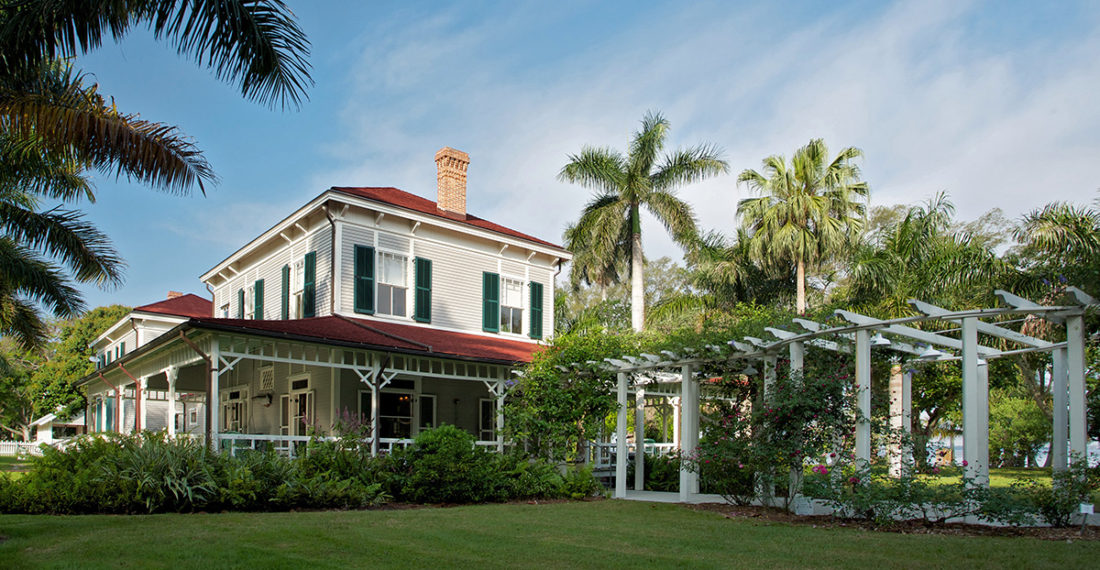
On the opposite sites of Thomas Edison and Henry Ford’s vacation residences beside the Caloosahatchee River in Southwestern Florida, the Edison and Ford Winter Estates contain a history museum and a 21-acre (8.5-hectare) botanical garden. There is also a garden centre (the Garden Shoppe) where you may buy hundreds of plants and trees. It’s in Fort Myers, Florida, at 2350 McGregor Boulevard.
The Edison and Ford Winter Estates were added to the American Institute of Architects’ Florida Chapter’s list of Florida Architecture: 100 Years on April 18, 2012. There are 100 of them. The Edison Botanical Research Laboratory at the Edison & Ford Winter Estates was named a National Historic Chemical Landmark by the American Chemical Society on May 25, 2014.
Vizcaya Museum and Gardens

The Vizcaya Museum and Gardens, formerly known as Home Vizcaya, is a former villa and estate on Biscayne Bay in the present-day Coconut Grove area of Miami, Florida, once owned by billionaire James Deering of the Deering McCormick-International Harvester fortune. The Vizcaya estate also has huge Italian Renaissance gardens, a native woodland setting, and a traditional village outbuildings compound from the early twentieth century.
The environment and architecture were designed in the Mediterranean Revival architecture style, with Baroque components, and were influenced by Veneto and Tuscan Italian Renaissance models. The architect was F. Burrall Hoffman, the design director was Paul Chalfin, and the landscape architect was Diego Suarez.
The Vizcaya site is presently owned by Miami-Dade County and is home to the Vizcaya Museum and Gardens, which is open to the public. The Vizcaya Station of the Miami Metrorail serves the area.
Cathedral Basilica of St. Augustine
It is a historic cathedral that serves as the seat of the Bishop of St. Augustine, Florida. It is at 38 Cathedral Place, at the intersection of Charlotte and St. George Streets. On April 15, 1970, it was recognised as a United States National Historic Landmark after being built over five years (1793–1797).
The Cathedral Basilica of St. Augustine is the oldest parish in the United States, having been founded in 1565 and later renovated in the 18th century. This landmark is a must-see for history aficionados, with a Spanish Renaissance bell tower, copies of paintings from the Vatican’s Pauline Chapel, and Victorian stained glass windows.
Ferdinand Magellan
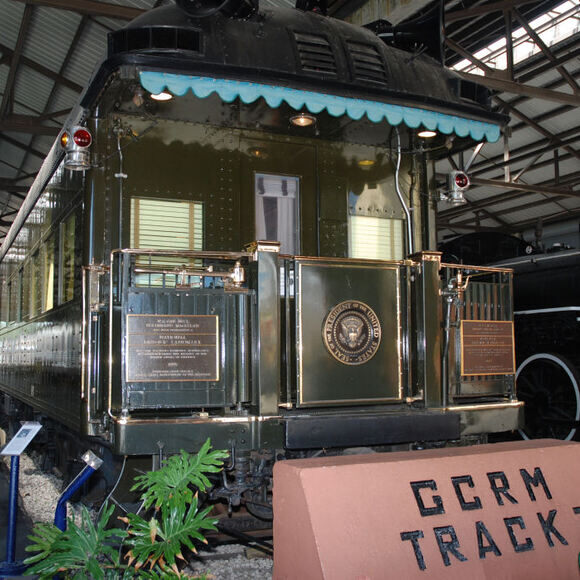
The armor-plated Ferdinand Magellan, also known as US Car Number 1, was built in 1928 and used as a Presidential Rail Car to transport President Franklin D. Roosevelt. It is presently on display at the Gold Coast Railroad Museum in Miami. It was the first presidential passenger rail car built since Abraham Lincoln, and it is still the only railcar listed as a National Historic Landmark. Other presidents who used the railroad car were Truman, Eisenhower, and Reagan. In reality, President Truman’s famous photo, in which he clutches a newspaper with the false headline indicating Dewey had won the election, was taken on the car’s rear platform.
Castillo de San Marcos

The Castillo de San Marcos in Florida is the continental United States’ oldest masonry fort.
Construction began in 1672, 107 years after the city was founded by Spanish Admiral and Conquistador Pedro Menéndez de Avilés during the Spanish Empire’s dominion in Florida.
Despite the fact that the fort was erected in part by Black Spanish slaves, it eventually served as one of the earliest entry points for British-owned African slaves entering Spanish lands, where they were emancipated by the Spanish. As a result, the first free Black community in the future United States was established soon. The National Park Service owned the Castillo in 1933, and it has since become a renowned tourist attraction. The view of the coast is equally breathtaking.
Ponce de Leon Lighthouse

The Ponce de Leon Inlet Light is a lighthouse and museum in Central Florida’s Ponce de Leon Inlet. It is the state’s and one of the country’s highest lighthouses, at 175 feet tall (the Cape Hatteras Light in North Carolina is 207 feet taller). It is situated between the lights of St. Augustine and Cape Canaveral. In 1998, the Ponce de Leon Inlet Lighthouse Preservation Association restored the lighthouse and it was designated as a National Historic Landmark.
Climb the 203 steps to the summit of Ponce de Leon Lighthouse for a spectacular panoramic view. This 175-foot historical landmark, which was completed in 1887, allows visitors to learn about the tower’s rich history.
Overseas Railroad

The Overseas Railroad was a branch of the Florida East Coast Railway that stretched between Key West and the Florida mainland. In the early 1900s, the Overseas Railroad was built to connect Florida’s mainland to Key West, which was 120 miles away. The hurricane of 1935 wreaked havoc on the railroad, rendering it useless. It was subsequently converted into the first Overseas Highway, but in the 1980s, it was replaced. The original train tracks can still be seen alongside the new roadway, and certain spots are suitable for strolling or fishing.
Henry B. Plant Museum

Railroad magnate Henry B. Plant erected this eye-catching specimen of Moorish Revival architecture in 1888. The Henry B. Plant Museum (Plant Museum) is located on the University of Tampa’s campus at 401 West Kennedy Boulevard in Tampa, Florida, in the south wing of Plant Hall. Plant Hall began life as the Tampa Bay Hotel, a 511-room resort-style hotel that opened on February 5, 1891 along the Plant System rail line, which was also developed and owned by Henry B. Plant. The Plant Museum’s exhibits focus on historical Gilded Age tourism in the Tampa Bay area of Florida, as well as the hotel’s opulent lifestyle and use during the Spanish–American War. As a result, the Plant Museum is designed in the style of a Historic House Museum. Artifacts are displayed in exhibits in a way that represents their original placement and use within the historic structure.
The Ringling

The John and Mable Ringling Museum of Art, the Circus Museum, the Ca’ d’Zan, and the gardens make up this remarkable Venetian-inspired property, which was mostly erected in the mid-1920s. The Ringling’s significant art collection, which includes works by Velazquez, El Greco, Van Dyke, Veronese, and Rubens, is on display in the art museum, which is housed in a magnificent pink palace.
The Circus Museum was added considerably later, in the late 1940s, to commemorate the history of this unique type of performance. It offers exhibitions on the history of the famed Ringling Bros. circus, as well as a variety of circus costumes, props, posters, and other memorabilia.
John and Mable Ringling made their home at the Ca’ d’Zan. Their travels through Europe and the famous palaces of Venice inspired them to build this Venetian-style house. The 36,000-square-foot mansion, which was constructed in 1926, is a southern Florida architectural marvel.
Venetian Pool
/GettyImages-dv1555020-5b9033e046e0fb0025bbeae7.jpg)
The Venetian Pool in Coral Gables, Florida, is a historic public swimming pool in the United States. It was designed by Phineas Paist and Denman Fink and completed in 1924.
This Venetian coral rock quarry, which was advertised as a “Venetian Casino” in 1924, is the largest freshwater swimming pool in the United States. It is the only pool on the National Register of Historic Places and a great site for cooling off on one of Florida’s sweltering summer days, in addition to the 820,000 gallons of freshwater it dispenses daily.


